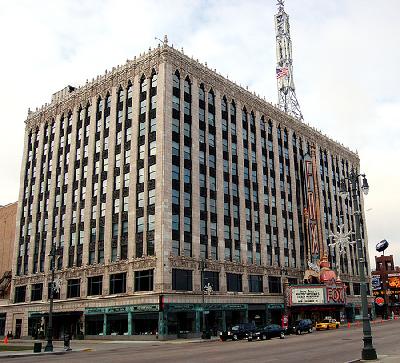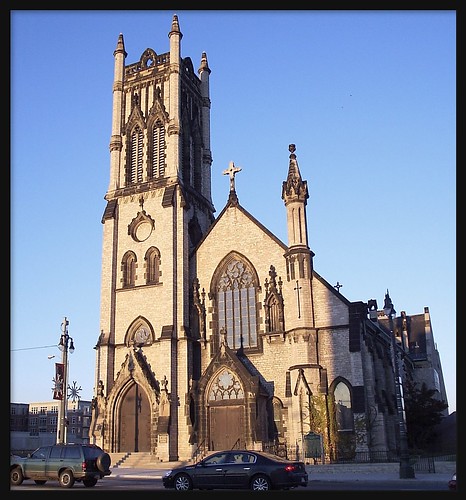Well, Andy Strasberg has done it again. Last year he sent along a few photos from his Fantography web site that provided great fodder for baseball research. Now he's sent along another beauty that, I must say, has been incredibly fun to research. Check out this photo:
Andy had no information about the image at all. What you see is what you get. So what do we see?
First, a quick perusal of the picture reveals the following information:
- some sort of parade is going on
- a baseball float dominates the scene
- given the size of the street and buildings, the location is likely a good-sized city
- Babe Dahlgren (1935-46)
- Eddie Lake (1939-41, 1943-50)
- Pee Wee Reese (1940-42, 1946-58)
- Bob Feller (1936-41, 1945-56)
- Dizzy Trout (1939-52, 1957)
- Birdie Tebbets (1936-42, 1946-52)
- Pat Mullin (1940-41, 1946-53)
Not much more can be gleaned from the float. Some of the kids on top are wearing uniforms with words or letters across the chest, but nothing definitive can be discerned. And the words on the side of the float are extremely difficult to read, though I suspect the upper words read "JUNIOR BASEBALL."
Let's move to the street. An address, street sign, or business sign would be helpful, but very little jumps out. Indeed, I could find only three clues in this vein.
The first clue is the advertising on the side of the building behind the float. Here is a close-up:

We are seeing just the left half of the advertising on the wall, so it is a challenge to determine exactly what is written. At the top are the letters 'CUNNI." Below that is a circle with just a few letters visible: "DOW" and "D" and "ST." (I wonder if this might not read something like "DOWN THE D--- STREET?") Below the circle are the words "BUSH & LANE" displayed vertically and "PIA" and "AND" and further down "SAL" and "5" displayed horizontally.
Thanks goodness for the unobstructed vertical "BUSH & LANE." This was the name of a piano company, which means that the "CUNNI" is likely "CUNNINGHAM" (also a piano manufacturer) and the "PIA" is assuredly "PIANO." In short, the wall is probably an advertisement for a store that sells pianos. Alas, this information does no help determine a date, location or explanation for the photo.
A second clue is the presence of two strange towers, one at the right side of the photo and the other behind the float. Here's a close-up of one:

The image on each tower appears to be a movie reel floating above an automobile. Could this be a sign for movie parking? If so, why are there two signs? And why such an elaborate sign for such a mundane purpose.
The final clue is tough to see. It is hidden far down the street and sits atop a building on the left side. Here's a detail from the photo:

Above the roof of a building, a sign with three letters reads, from top to bottom, "FOX." It's not a unique word, but it is one that is often associated with theaters. Could this be a Fox Theater?
Following this hunch, the next move is to search for theaters named "Fox." As one might guess, there are quite a few. In fact, the folks at Cinema Treasures, a web site devoted to classic movie theaters, has cataloged nearly 200 theaters with the word "Fox" in their name, half of which were known simply as "Fox Theater." From the Fox in Spokane, Washington to the Fox in Hollywood, California to the Fox in Hackensack, New Jersey to the Fox in Pensacola, Florida: it seems that the four corners of the country and everyplace in between has had (or still has) a Fox Theater.
Continuing with the hunch and putting everything together, our Fox Theater was located in a decent-sized city during the 1940s. While that should help eliminate a number of theaters, it still lays before us a daunting task: which Fox is our Fox?
After hours of "Fox hunting," I managed to track down this image of the Fox Theater at 2211 Woodward Avenue in Detroit, Michigan.

Photo courtesy of http://www.scottymoore.net/detroit56.html
The vertical "FOX" sign on this building is slightly different than that seen on our mystery image, but the above photo was taken in recent times, not back in the 1940s. It is reasonable that the FOX sign may have changed a bit over the years, so I decided to dig a little further and found another image of the Fox Theater in Detroit:

Photo courtesy of http://commons.wikimedia.org/wiki/Category:Fox_Theatre_(Detroit,_Michigan)
What is interesting about this modern photo of the theater is that across Woodward Avenue and down a block or so there is a church with a steeple. Referring to our baseball float photo, we see a similar church and steeple on the other side of the street from the building topped by the "FOX" sign. A quick look at a map of the area reveals that the church is the Central United Methodist Church at 23 East Adams (the corner of Woodward Avenue and Adams).
So both the Central United Methodist Church and the Fox Theater are still standing on Woodward Avenue. If only we could go to Detroit, walk down Woodward Avenue and see if any of the buildings we see match those in our mystery photo. Well, thanks to Google Street View, we can virtually take a walk down Woodward Avenue, so I did just that.
I started at the Fox Theater in Detroit and "walked" southeast on Woodward. Here's the view southeast with the Fox Theater on the right:

After "walking" few blocks southeast, I got to the Central United Methodist Church. Here's the view looking back (northwest) at the Fox Theater (on he left) from the church (on the right):

And, after "walking" a number of blocks further southeast, I turned around and looked back (northwest) at this scene:

We're just about half a block south of John R Street, looking northwest up Woodward Avenue, and voila! It's a perfect match with our baseball float photo. (Click here to enter Google Street View at the above location).
Revisiting the float photo, let's explore some of the distinctive buildings seen here on Woodward Avenue in Detroit.

A) Fox Theater, 2211 Woodward Avenue.
B) Central United Methodist Church, 23 East Adams Avenue (corner of Woodward and Adams)
C) Fyfe Building, 10 West Adams (corner of Woodward and Adams). Here's a great photo:

Photo courtesy of Detroit Publishing Company Photograph Collection, LC-D41-40
D) David Broderick Tower, 10 Witherell Street (corner of Woodward and Witherell). Here's a picture of the Broderick Tower (on the left):

Photo courtesy of http://brodericktower.com
E) Wright-Kay Building (also known as the Schwankovsky Temple of Music), 1500 Woodward Avenue. This is an absolutely gorgeous building and, apparently, the first in Detroit to have an electric elevator. Here is a photo:

Photo courtesy of http://detroit1701.org/Schwankovsky.htm
F) St. John’s Episcopal Church, 50 East Fisher Freeway. Hard to see in the baseball float photo as it is pretty far away. Here's a photo:

Photo courtesy of http://www.flickr.com/photos/71288712@N00/2383972369
So there's no doubt exactly where the photo was taken. But when was it taken? When was there a World War II-era parade on Woodward Avenue? Here's the answer:
Back in 1946, Detroit held the Automotive Golden Jubilee, a two-week celebration of the end of the war and war-time related manufacturing and a return to doing what Detroit did best: making cars. On June 1, 1946, the World's Fair-like celebration reached a climax with the Motor City Cavalcade, a parade down Woodward Avenue.
The Detroit Public Library has an excellent online exhibit about the Jubilee. The site features the following image of the cover of the Jubilee program:

Recognize the logo? It's the same "movie reel" floating above a car seen on the towers in the baseball float photo. But that's not a movie reel, it's a wheel orbited by electrons, a symbol of the automobile industry moving into the atomic age.
The following image of the parade is from Life magazine in 1946:
Note the numerous towers topped by the Jubilee logo, identical to those seen in our float photo. There's no question that our mystery photo was taken at this parade.
Amazingly, there is even footage of the parade on YouTube.
So, the baseball float photo was taken during the Motor City Cavalcade parade on June 1, 1946, from a location just about half a block south of John R Street, looking northwest up Woodward Avenue in Detroit.
But what of the baseball float? What is its story? Alas, I have been unable to find any information about that particular float. Perhaps one of my readers can help solve that final mystery.



















